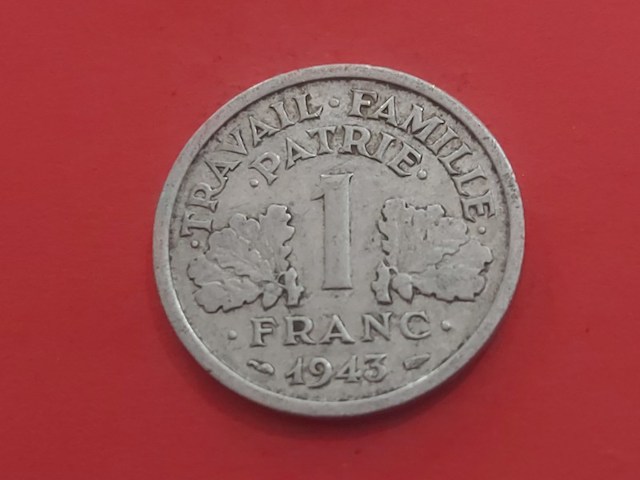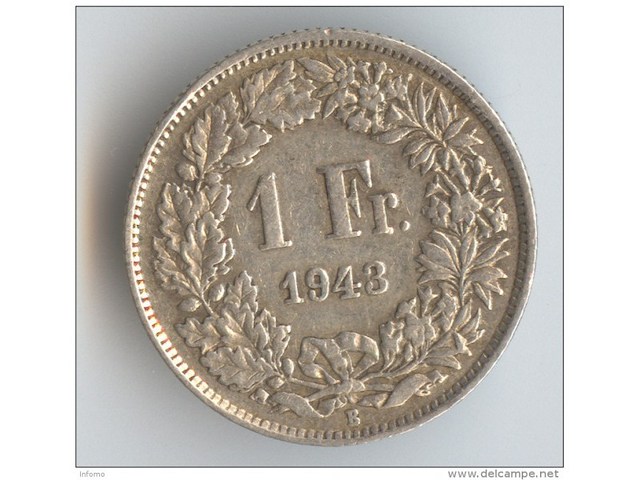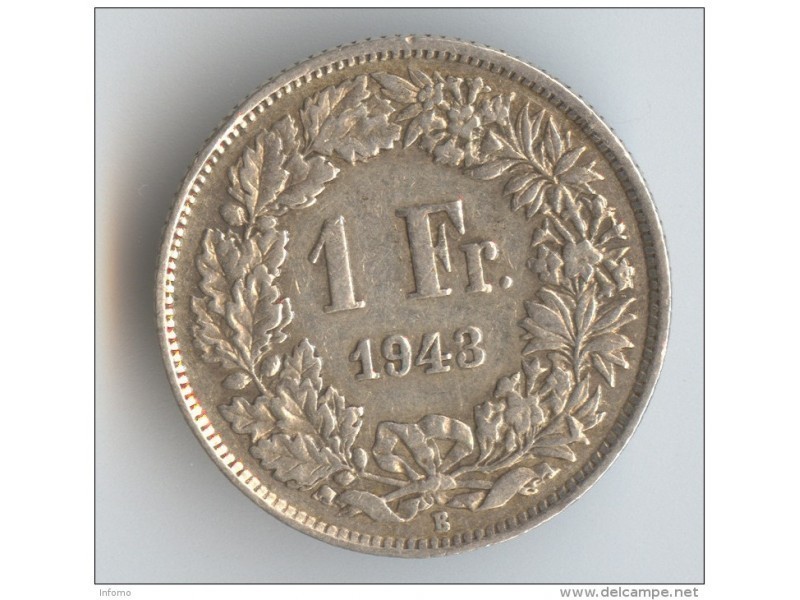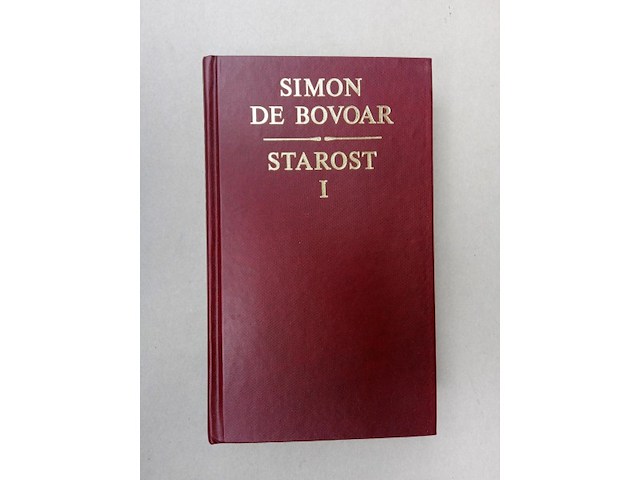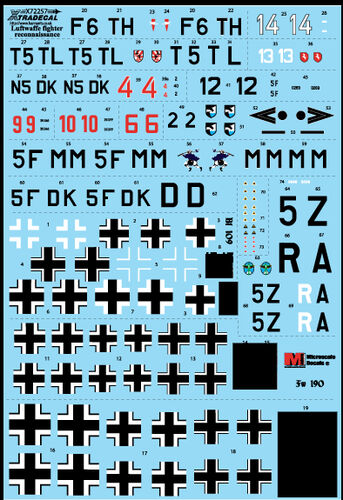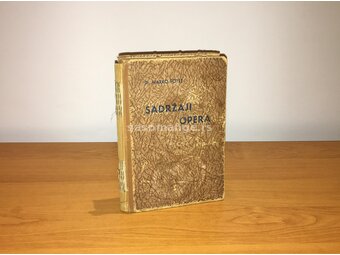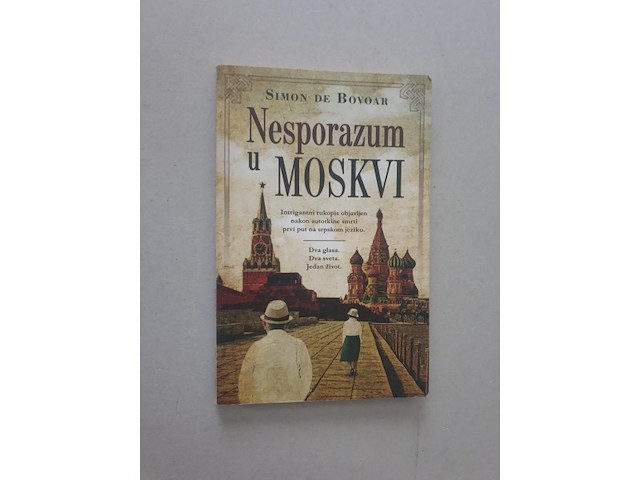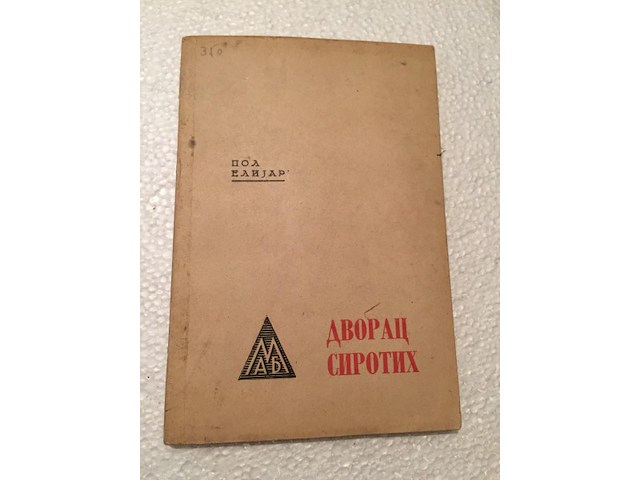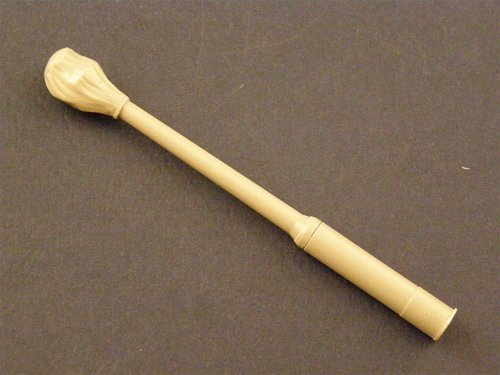Pratite promene cene putem maila
- Da bi dobijali obaveštenja o promeni cene potrebno je da kliknete Prati oglas dugme koje se nalazi na dnu svakog oglasa i unesete Vašu mail adresu.
1-25 od 96 rezultata
Prati pretragu " 1.FRANC-1943"
Vi se opustite, Gogi će Vas obavestiti kad pronađe nove oglase za tražene ključne reči.
Gogi će vas obavestiti kada pronađe nove oglase.
Režim promene aktivan!
Upravo ste u režimu promene sačuvane pretrage za frazu .
Možete da promenite frazu ili filtere i sačuvate trenutno stanje
Aktivni filteri
-
Cena
0 din - 799 din
-
Kolekcionarstvo i umetnost chevron_right Kolekcionarstvo
Sa slika (0107)
-
Kolekcionarstvo i umetnost chevron_right Numizmatika
Detalji predmeta Stanje Polovno Zemlja porekla svajcarska Očuvanost XF Godina 1941 - 1950. Originalnost Original Kulturno dobro Predmet koji prodajem nije kulturno dobro ili ovlašćena institucija odbija pravo preče kupovine /
Spoljašnjost kao na fotografijama, unutrašnjost u dobrom i urednom stanju! Simon de Bovoar (franc. Simone de Beauvoir;[1] Pariz, 9. januar 1908 — Pariz, 14. april 1986) bila je francuska književnica, filozofkinja egzistencijalizma, teoretičarka, politička aktivistkinja i feministkinja.[2] Bila je životna saputnica filozofa Žan-Pola Sartra. Od 1931. do 1941. bila je profesorka filozofije u Marseju, Ruanu i Parizu, a od 1943. se posvetila književnosti. Pisala je romane, drame, eseje i memoare. Neka od njenih poznatijih dela su romani egzistencijalističke tematike: „Gošća“, „Krv drugih“, „Svi su ljudi smrtni“ i „Mandarini“, drama „Nekorisna usta“ i memoari „Uspomene lepo vaspitane devojke“. Poznata je i po eseju „Drugi pol“ (franc. Le Deuxième Sexe), koji predstavlja detaljnu analizu ugroženog položaja žene i utemeljuje osnove feminizma. Simon de Bovoar je rođena u Parizu, 9. januara 1908. Njeni roditelji bili su Fransoa de Bovoar i Bertrand de Bovoar, a imala je i dve godine mlađu sestru Helen, koja je postala slikarka.[3] Budući da su izgubili puno materijalnih dobara tokom Prvog svetskog rata, porodica se borila da zadrži svoj buržoaski status. Ipak, Simon i Helen su se školovale u jednoj od najprestižnijih samostanskih škola. De Bovoar je bila veoma religiozna devojčica i nameravala je da postane častna sestra. Međutim, u svojim „tinejdžerskim” godinama, izgubila je svoju veru i ostala je ateista do kraja svog života...
Osnovne informacije Proizvođač Xtradecal Šifra proizvoda: XDL-72257 Težina 0.03 kg Skala 1:72 Dodato je u katalog: 12.8.2023 Tagovi Focke-Wulf-Fw-190 Me-110 Messerschmitt-Me-109 Luftwaffe Reconnaissance Fighters (13 schemes) Messerschmitt Bf-109 F/G, Focke-Wulf 190A-4 / F6 and Messerschmitt Bf-110 D/E Bf-109F-6 R2 +TH 1.(F)y/122 Sardinia 1942; Bf-109F-4 R2 T5+TL Aufklarunsgruppe(F) Ob.d.L Kharkov 1942; Bf-109G-3 R2 White 13 NAGr.11 Mediterranean 1942; Bf-109G-8 R2 White 14 2/NAGr12 Albania 1944 Hmpt Heimo Emmerstorfer; Bf-109G-8 R2 Red 4 N5+DK Nahauufklarungsgruppe Bromberg, 1945; Bf-109G-10/R2 2./AGr 14 Furth, Germany 1945 12+5F; Fw-190A-3/U4 Red 9 and 10 5.(F)/123 St.Pol France 1943; Fw-190A-4/U4 Red 6 Unit unknown probably based Sicily 1943; Fw-190A-4/U4 <+- and Black 2 Stabskette/NAGr.13 Dinard France 1943; Bf-110E-3/U2 5F+MM 4.(F)/14 Cherbourg, 1940; Bf-110D-3 Trop 5F+DK 2.(H)/14 Nth Africa RLM79/80 Desert Camo; Bf-110D-4/U2 3Z+RL Wekusta 76 Eastern Front 1941; Greška u opisu? Prijavi problem
Autor - osoba Jarry, Alfred, 1873-1907 = Žari, Alfred, 1873-1907 Naslov Ibi ponovo jaše : drame i proza o Ibiju / Alfred Žari ; izbor, prevod i predgovor Vlada Stojiljković Jedinstveni naslov Tout Ubu. srpski jezik Vrsta građe drama Jezik srpski Godina 1998 Izdanje [1. izd.] Izdavanje i proizvodnja Beograd : Paideia, 1998 (Beograd : Publikum) Fizički opis 169 str. : ilustr. ; 21 cm Drugi autori - osoba Stojiljković, Vlada Zbirka ǂBiblioteka ǂSvetska književnost (broš.) Napomene Prevod dela: Tout Ubu / Alfred Jarry Tiraž 2.000. Ibi često govori o trima stvarima, koje su u njegovoj glavi uvek jedna uz drugu: o fizici, naime o prirodi za razliku od umetnosti; minimumu poimanja nasuprot maksimalnoj cerebralnosti, i paralelno, o finansijama, naime počastima ukazanim zadovoljavanju svoga Ja isključivo sebe radi nasuprot moći poimanja koja karakteriše inteligentne ljude; i paralelno, o zgovnima. Alfred Žari (franc. Alfred Jarry; 8. septembar 1873 – 1. novembar 1907) bio je francuski simbolistički pisac, dramaturg i pesnik. Najpoznatiji je po delu Kralj Ibi (1896), koje je izazvalo burnu reakciju javnosti. On je takođe skovao i psihološki termin patafizičar. Biografija Žari je rođen u Lavalu, a njegova majka je iz Britanije. Bio je povezan sa simbolističkim pokretom. Njegovo delo Kralj Ibi često se navodi kao preteča dadaizma, pa čak i nadrealizma i futurizma 20ih i 30ih godina dvadesetog veka. Žari je pisao različitim žanrovima i stilovima, ali je mahom preferirao postmodernistički. Pisao je romane, drame, poeziju, eseje, a bavio se i spekulativnim novinarstvom. Njegovi tekstovi predstavljaju pionirski rad iz oblasti apsurdne književnosti i postmoderne filozofije. Dela Predstave César-Antéchrist (Cezar Antihrist, 1895) Ubu roi (Kralj Ibi, 1896) Ubu Cocu, ou l`Archeopteryx (1897) Ubu Enchaíné (1899) Ubu Sur La Butte (1906) Romani Otac Ibi (kasnije Kralj Ibi), duborez Alfreda Žarija Les Jours et Les Nuits, roman d`un déserteur (Dani i noći, roman dezertera, 1897) L`Amour en Visites (Posete Amora, 1897) L`Amour Absolu (Apsolutna ljubav, 1899) Messaline (1900) Le Surmâle (Supermuškarac, 1901) Gestes et Opinions du Docteur Faustroll, Pataphysicien – Dela i misli doktora Faustrola, patafizičara, objavljeno posthumno 1911. La Dragonne – priređeno i objavljeno posthumno 1943. Druga značajna dela Kratka priča La Passion considérée comme course de côte Les Minutes De Sable Memorial (1894) – kolekcija ranih kratkih dela La Chandelle Verte: Lumieres Sur Les Choses De Ce Temps MG95 (N)
Osnovne informacije Proizvođač Braille Strike Šifra proizvoda: BRL72140 Težina 0.01 kg Skala 1:72 Dodato je u katalog: 26.4.2023 Tagovi Howitzer-Motor-Carriage-M8 Decal sheet including markings for 4 M8 howitzers belonging to the French 1st and 5th Armored Divisions: -M8 HMC, 5th French Armored Division, 1st Foreign Cavalry Regiment, 5th Squadron, Morocco, 1943. -M8 HMC, “BELFORT”, 2nd Algerian Reconnaissance Spahis Regiment, 3rd Squadron, Aach, Germany, April 1945. -M8 HMC, ‘KELLERMANN’, 2nd Moroccan Infantry Division, 3rd Moroccan Spahis Reconnaissance Regiment, Montbéliard, France, November 1944. -M8 HMC, 1st Free French Division, 1st Marine Fusiliers Regiment, 3rd Recce Squadron, 2nd Platoon, Monaco, France, May 1945. RECOMMENDED USAGE: Apply a layer of gloss varnish on model before setting the decal, and another layer after to protect the decal during the weathering process and to avoid silvering. Greška u opisu? Prijavi problem
Osnovne informacije Proizvođač Braille Strike Šifra proizvoda: BRL35140 Težina 0.01 kg Skala 1:35 Dodato je u katalog: 26.4.2023 Tagovi Howitzer-Motor-Carriage-M8 Decal sheet including markings for 4 M8 howitzers belonging to the French 1st and 5th Armored Divisions: -M8 HMC, 5th French Armored Division, 1st Foreign Cavalry Regiment, 5th Squadron, Morocco, 1943. -M8 HMC, “BELFORT”, 2nd Algerian Reconnaissance Spahis Regiment, 3rd Squadron, Aach, Germany, April 1945. -M8 HMC, ‘KELLERMANN’, 2nd Moroccan Infantry Division, 3rd Moroccan Spahis Reconnaissance Regiment, Montbéliard, France, November 1944. -M8 HMC, 1st Free French Division, 1st Marine Fusiliers Regiment, 3rd Recce Squadron, 2nd Platoon, Monaco, France, May 1945. RECOMMENDED USAGE: Apply a layer of gloss varnish on model before setting the decal, and another layer after to protect the decal during the weathering process and to avoid silvering. Greška u opisu? Prijavi problem
-
Kolekcionarstvo i umetnost chevron_right Knjige
Detalji predmeta Stanje Polovno Rikna oštećena pri vrhu Наслов Zlatko Šulentić / Željko Grum ; [fotografije Nino Vranić, Mitja Koman ; prijevod na francuski Khedidja Mahdi-Bolfek, prijevod na engleski Gregor Mc Gregor] Врста грађе каталог Језик хрватски, француски, енглески Година 1974 Издавање и производња Zagreb : Moderna galerija : Grafički zavod Hrvatske, 1974 (Zagreb : Grafički zavod Hrvatske) Физички опис 144 str. : ilustr. ; 24 cm Други аутори - особа Koman, Mitja Zlatko Šulentić (Glina, 16. mart 1893 – Zagreb, 8. jul 1971) bio je hrvatski slikar, važna figura druge generacije hrvatskog modernizma, autor niza ikoničnih dela sa ličnim likovnom stilom. Savremeni umetnik, koji je na kraju šezdesetih bio majstor ekspresivne boje i prikaza dubinski sadržaj u ljudskim, slikarskim komunikacijama, izraženih kroz pokrete rukama i glavom ili drugih delova tela koji izražavaju neku misao, ili osećaj.[1] Zlatko Šulentić Датум рођења 21. mart 1893. Место рођења Glina Austrougarska Датум смрти 8. јул 1971. (77/78 год.) Место смрти Zagreb SFRJ Sadržaj Život i karijera Uredi Rođenje u Glini 16. marta 1893. godine. Studirao je slikarstvo na Akademiji u Minhenu (1911–1914). Dugo godina radio je kao likovni pedagog u srednjim školama u Petrinji i na Sušaku, a potom na zagrebačkoj Akademiji likovnih umjetnosti (1938–1971).[1] Preminuo je 16. jula 1971. godine u Zagrebu u 78 godini života.[1] Likovno stvaralaštvo Uredi Slikom iz studentskih dana Kasna jesen (1913), naslikanom slobodnim potezima četkice i kontrastnim tonovima, Zlatko Šulentić se prvi put predstavio kao slikar izrazitog kolorizma, koji je najbvolje uočljiv na modeliranim i psihološki produbljenim portretima (npr. Portret dr. Žanića, 1913; Čovjek s crvenom bradom, 1916; Portret dr. Stjepana Pelca, 1917; Portret Nikole Matanića, 1922; Portret arhitekta Pičmana, 1926) nastalimpod uticajem ekspresionizma.[2] U stvaranju sopstvenog stilskog izraza kratko je bio pod uticajem sezanizma i kubizma. U delima iz tog perioda na Šulentićevim slikama se nazire u prozračnosti i lakoći zatvorenih oblika i njegovom remek-delu Place du Tertre (1930). U bogatom kolorizmu i istančanoh harmoniji nastao je Đulentićev ciklusu ulja, crteža i akvarela iz Španije i Alžira (1920–1921). Od kraja 1930-ih u pejzažima, mrtvim prirodama, portretima i aktovima Zlatko Šulentić je ostvario jak koloristički intimizam sa gotoovo vidljivom ekspresionističkom žestinom. U njegovu se opusu izmjenjuju i prožimaju čvrstoća oblik i koloristička razigranost kojom se približio lirskoj apstrakciji u delima Bačun, 1943; Moj vrt, 1957; Plješivički vinogradi, 1966; Ljubice, 1968.[1] U posljednjoj deceniji života slikao je i biblijske kompozicije, od kojih se neke nalaze u crkvi i samostanu Svetog Franje Ksaverskoga u Zagrebu. Objavio knjigu uspomena s putovanja po Španiji, Africi i Južnoj Americi Ljudi, krajevi i beskraj (1971) i u njoj prikazao i dokumentacija o istraživačima braći M. i S. Seljanu.[1] Likovna dela Uredi Kasna Jesen , 1913 Autoportret , 1915 Iz Maksimira, 1915 Čovjek s crvenom bradom, 1916 Portret dr Stjepana Pelca, 1917 Primorska ulica, 1918 Tunis, 1920 Moj otac, 1925 Portret arh. Pičmana, 1926 Autoportret, 1929 Place du Tertre, 1930 Banka, 1932 Djevojčica sa šeširom, 1934 S. Giovanni i Paolo,Venecija, 1935 Samoborski kraj, 1938 Podne, 1939 Portret Andreje Wendler-Vojta, 1946 Vrbnik, 1947 Sv. Donat, 1949 Iza kazališta I, 1952 Fontana di Trevi, 1957 Ante, 1958 Pogled sa đipana, 1962 Đipan Fields (Đipansko polje), 1962 Autoportret, 1963 Sto stuba, 1964 Plješivički vinogradi II, 1966 Staru svjetiljku, 1966 Đipanski bor, 1967 Ampirsku uru, 1968 Silba, 1968 Napuštena barka, 1969 Dijete, 1970 Raspeće, 1971 Izložbe Uredi Samostalne izložbe 2011. — Retrospektivna izložba, Umetnički paviljon Zagreb.[2] 2010. — Slike Zlatka Šulentića, Galerija „Ulrich”, Zagreb 2006. — Zlatko Šulentić: Portreti, „Adris Gallery”, Rovinj 1969. — Slike Zlatka Šulentića, Štrosmajerova galerija, Zagreb Grupne izložbe 2006. — Hrvatska kolekcija slika - Museum of Contemporary Art Skopje, Skopje Priznanja Uredi Dobitnik je Nagrade „Vladimir Nazor” za životno Delo (1969).[1] Zbirke Uredi Radovi Zlatko Šulentić dana se mogu naći u sledećim javnim zbirkama: Muzej savremene umjetnosti, Zagreb Moderna galerija, Zagreb Strosmajerova galerija starih majstora, Zagreb Muzej savremene umetnosti, Beograd Muzej savremene umetnosti, Skoplje Pored navedenih zbirki, više od stotinu slikarovih skica i studija u tehnici gvaša, tuša i olovke sačuvano je do danas u raznim crkvenim i samostanskim zbirkama u Hrvatskoj, a dvadesetak i u Hercegovini.[1] Izvori Uredi „Šulentić, Zlatko, Hrvatska enciklopedija”. Приступљено 7. 5. 2020. Radovan Vuković, Zlatko Šulentić, 2011, Umetnički paviljon u Zagrebu Literatura Uredi Zlatko Šulentić by Mladen Pejaković. Monografija. Publisher:Art studio Azinović; ISBN 978-953-6271-70-2 Zlatko Šulentić - Tragom onostranog i svetog (Zlatko Šulentić - On the Trail of the Transcendental and the Sacred) by Ivanka Reberski. Monografija. Publisher: Požeška biskupija, 2009. ISBN 978-953-7647-04-9 Spoljašnje veze Uredi Slika Zlatka Šulentića "Posljednja večera" na Ksaveru Vranić, Nino Mahdi-Bolfek, Khedidja Gregor, Mc Gregor Збирка ǂBiblioteka ǂModerna Hrvatska umjetnost ; 1 ISBN (Karton) Напомене Deo teksta uporedo na hrv., franc. i engl. jeziku Biografija: str. 111-116 Summary ; Résumé Bibliografija: str. 138-141 Registri. Предметне одреднице Шулентић, Златко, 1893-1971 -- Репродукције -- Изложбени каталози УДК 75.071.1:929 Шулентић З.(083.824) O slikaru: Hrvatski slikar Zlatko Šulentić bio je slikar ugođaja, pejsažist i portretist. Počeo je slikati u ranoj mladosti začudnom kvalitetom i senzibilnošću, koja je svojstvena njegovu kasnijem radu. Odlučujući susret za rano umjetnikovo razdoblje bio je susret sa slikama Miroslava Kraljevića i modernijim shvaćanjima umjetnosti.
Osnovne informacije Proizvođač Xtradecal Šifra proizvoda: XDL-48207 Težina 0.02 kg Skala 1:48 Dodato je u katalog: 7.8.2023 Tagovi Tiger-moth de Havilland DH.82a Tiger Moth Part 3 - Overseas Operators (7 schemes) DE-832/9 of French Pilots School, Armee de l'Air, Cognac, Charente, France 1948. 53 of SK.11, Flygvapnet, (Swedish Air Force) 1932. 107 of Forca Aerea Portuguesa, (Portugeuse Air Force) 1937-40. 2-I-2 of Marinha do Brasil, Brazil, 1935. 002/V of Koninklijke Marine, based at Valkenburg en De Kooy, Netherlands, late-1950s. T-2 of Belgisch Militaire Vliegwezen/Aviation Militaire Belge, Goetsenhoven, Belgium, 1950s. DE745/Dorothy of 353rd Fighter Group, United States Army Air Force, based at Goxhill, North Lincolnshire, UK, Summer, 1943. Greška u opisu? Prijavi problem
-
Kolekcionarstvo i umetnost chevron_right Muzika i film
format: LP, French edition artist: HALLIDAY, Johnny (France) title: Rock A Memphis release date: 1975 label, Cat.No.: Philips – 9101 009 style: rock / pop Ploča i omot: VG- (4-), insert: M (5), vrlo dobar primerak. Francuski original, 1. pressing, sa crnom etiketom i omotom od debljeg kartona. Ovo je ko-zna-koja LP ploča po redu najveće francuske rock zvezde svih vremena. Džoni (tj. Jean-Philippe Léo Smet, 1943-2017) na ovoj ploči peva velike RnR hitove Carl Perkinsa, Eddie Cochrana, Chuck Berry-ja, Jerry Lee Lewisa i dr. - na francuskom. A1 Ma Chérie, C`est Moi `It`ll Be Me` 2:49 A2 37ème Étage.... `Twenty Flight Rock` 1:44 A3 La Fille De L`été Dernier `Summertime Blues` 2:21 A4 Dégage `Slow Down` 2:44 A5 Jeanie, Jeanie, Et Ta Soeur `Jeanie, Jeanie, Jeanie` 2:28 A6 Ma Mississipi Queen `Get Back Memphis` 2:14 A7 Tutti, Frutti 2:23 B1 Memphis, USA `Memphis` 3:14 B2 Oh! Sally `Long Tall Sally` 1:56 B3 Comme Un Fou `Stuck On You` 2:29 B4 Qu`est Ce Que Tu Fais A L`école? `High School Confidential` 2:28 B5 Un Garçon Sur La Route `Match Box` 2:06 B6 Adieu, Miss Molly `Good Golly, Miss Molly` 2:12
MARKO FOTEZ SADRŽAJI OPERA - 260 sadržaja najpoznatijih domaćih i stranih opera, opereta i baleta Predgovor - Antun Dobronić Prevod - Dinko Sirovica Izdavač - ? ? ? , Zagreb Godina - 1943 XXXII + 440 strana 21 cm Povez - Tvrd Stanje - Kao na slici, tekst bez podvlačenja SADRŽAJ: 1 HRVATSKI ALBINI SREĆKO Barun Trenik Bosonoga plesačica Madame Troubadour Maricon BARANOVIĆ KREŠIMIR Imbrek z nosom Licitarsko srdce Striženo-košeno Turci idu BERSA BLAGOJE Oganj Postolar od Delfta DOBRONIĆ ANTUN Div-konjic Dubrovački diptihon Ekvinocijo Goranin Mara Ognjište Pobratimski darovi Pobuna limunove čete Požar strasti Udovica Rošlinka GOTOVAC JAKOV Ero s onoga svieta Morana HATZE JOSIP Adel i Mara Povratak LISINSKI VATROSLAV Ljubav i zloba Porin LHOTKA FRAN Đavo u selu Minka More Sredovječna ljubav LHOTKA-KALINSKI IVO Pomet NOVAK VILKO Proljetna bura ODAK KRSTO Dorica pleše Konac svieta PARAĆ IVO Adelova pjesma PAPANDOPULO BORIS Amfitrion Sunčanica Zlato ŠAFRANEK-KAVIĆ LUJO Figurine Hasanaginica Medvedgradska kraljica Sanje ŠIROLA BOŽIDAR Citara i bubanj Grabancijas Mladi gospodin Sjene Stanac VILHAR-KALSKI F S Lopudska sirotica ZAJC PL IVAN Ban Leget Lizinka Momci na brod Nikola Šubić Zrinski Otčenaš Prvi grieh Vitežka ljubav 2 SLAVENSKI BORODIN ALEKSANDER PORFIREVIĆ Knez Igor BLODEK VILEM Na zdencu ČAJKOVSKI PETAR ILJIČ Evgenij Onjegin Mazepa Pikova dama Ščelkunčik DVORAK ANTONIN Dmitrij Jakobinac Kralj i ugljenar Lukavi seljak Rusalka Tvrde glave GLINKA MIHAJL IVANOVIĆ Život za cara JANAČEK LEOŠ Iz mrtvoga doma Jenufa Katja Kabanova Mudra lija (Liška bistrouška) JEREMIAŠ OTOKAR Braća Karamazovi KONJOVIC PETAR Knez od Zete Koštana Ženitba Miloševa KOVAROVIĆ KAREL Pasoglavci KRENEK ERNEST Jonny svira MONIUSZKO STANISLAV Halka MUSORGSKI MODEST PETROVIC Boris Godunov Hovanščina Soročinski sajam Ženitba NEDBAL OSKAR Iz priče u priču Poljačka krv Priča o Honzi Vincilirka NOVAK VITEZSLAV Lucerna Mladost Nikotina PARMA VIKTOR Caričine Amazonke Ksenija Stara pjesma RIMSKI-KORSAKOV NIKOLAJ ANDREJEVIČ Carska nevjesta Priča o nevidljivu gradu Kitežu Sadko Snjeguročka Šeherezada RUBINSTEIN ANTON Demon SAVIN RISTO Matija Gubec SMETANA BEDRICH Branibori u Češkoj Dalibor Dvie udovice Libuša Poljubac Prodana nevjesta Tajna STRAVINSKI IGOR Kralj Edip Petruška Žar-ptica ŠOŠTAKOVIĆ DIMITRIJ Katarina Izmajlova WEINBERGER JAROMIR Gajdaš Švanda 3 OSTALI ADAM CHARLES ADOLPH Poštar od Lonjumeau-a D' ALBERT EUGEN Kći mora Mrtve oči Odlazak U dolini AUBER DANIEL FRANÇ OIS ESPRIT Fra Diavolo Niema od Portici BEETHOVEN LUDWIG VAN Fidelio BELLINI VINCENZO Mjesečarka Norma BIZET GEORGES Carmen Djamileh Lovci bisera BLECH LEO Zapečaćeno BOILDIEU ADRIEN FRANÇ OIS Biela gospođa BOITO ARRIGO Mefistofele CATALANI ALFREDO La Wally CHARPENTIER GUSTAVE Louise CILÈ A FRANCESCO Adriana Lecouvreur CIMAROSA DOMENICO Tajni brak DEBUSSY CLAUDE ACHILLE Peleas i Melisanda DELIBES LEO Kopelija Lakmé DONIZETTI GAETANO Don Pasquale Favoritkinja Kći regimente Lucia Lamermorska Ljubavni napitak EGK WERNER Kolumbus FLOTOW VON FRIEDRICH GIORDANO UMBERTO GLUCK KRISTOF WILLIBALD GOLDMARK KARL GOUNOD CHARLES FRANÇ OIS HALEVY ELIE FROMENTAL JACQUES HAYDN JOSEPH FRANZ HUMPERDINCK ENGELBERT KIENZL WILHELM KORNGOLD ERICH WOLFGANG LEHAR FRANZ LEONCAVALLO RUGGERO LORTZING GUSTAV ALBERT MAILLART LOUIS AIME MASCAGNI PIETRO MASSENET JULES EMIL FREDERIC MEYERBERGER GIACOMO MILLÖ CKER KARL MOZART WOLFGANG AMADEUS NICOLAI OTTO OFFENBACH JACQUES PERGOLESI GIOVANNI BATTISTA PONCHIELLI AMILCARE PUCCINI GIACOMO RABAUD HENRI RESPIGHI OTTORINO ROCCA LODOVICO ROSSINI GIOACCHINO ANTONIO SAINT-SAË NS CAMILLE CHARLES SCHILLINGS VON MAX SCHRECKER FRANZ STRAUSS JOHANN STRAUSS RICHARD SUPPÉ FRANZ THOMAS AMBROIS CHARLES LOUIS VERDI GIUSEPPE WAGNER RICHARD WEBER CARL MARIA WOLF HUGO WOLF-FERRARI ERMANO ZANDONAI RICCARDO Ako Vas nešto zanima, slobodno pošaljite poruku. Musorski Viteslav Vajnberger Čarls Adolf Ober Danijel Fransoa Ludvig Betoven Vinćenco Belini Žorž Bize Lio Blah Katalani Gistav Karpentje Frančesko Klod Debisi Gaetano Doniceti Verner Flotov Fridrih Đorđo Glak Vilibold Jozef Franc Hajdn Žak Halevi Vilhelm Kajncl Pjetro Mašćani Đakomo Mejerberger Volfgang Mocart Žak Ofenbah Đakomo Pučini Anri Rabo Maks Šilings Šreker Johan Rihard Ričard Štraus Đuzepe Verdi Vagner Karl Marija Veber Igo
Osnovne informacije Proizvođač Xtradecal Šifra proizvoda: XDL-32067 Težina 0.02 kg Skala 1:32 Dodato je u katalog: 7.8.2023 Tagovi Messerschmitt-Me-109 Messerschmitt Bf-109 E/F/G/K Stab Part 2 (8 schemes) Bf-109E-4 III/JG 77 Greece 1941 Yellow nose/rudder; Bf-109E-4 I/JG 3 CO Hptm Hans Von Hahn Late 1940, St Omer France, Yellow nose/rudder; Bf-109F-2 I/JG 3 Tech Offizer Hptm Detlev Rohwer Ukraine 1941 Yellow nose/fuselage band, includes correction for spinner stripes; Bf-109F-2 II/JG 53 Gruppenkommandeur Hptm Heinz Bretnutz, St Omer 1941. Yellow nose/rudder; Bf-109F-4 JG 54 Adjutant Russia 1941/42. Mainly white with Yellow nose/rudder/fuselage band; Bf-109G-2 Stab JG 77 Maj Joachim Muncheberg Egypt 1943. RLM79 Sand/RLM68; Bf-109G-2 Kommodore JG 54 Maj Trautloft Eastern Front 1941; Bf-109K-4 Adjutant III/JG 53 Germany 1945 Greška u opisu? Prijavi problem
Spoljašnjost kao na fotografijama, unutrašnjost u dobrom i urednom stanju! Intrigantni rukopis objavljen nakon autorkine smrti prvi put na srpskom jeziku. Dva glasa. Dva sveta. Jedan život. Nastavila je školovanje, zaklela se da će se usprotiviti svojoj sudbini: napisaće doktorsku tezu koja će podići prašinu, dobiće katedru na Sorboni, dokazaće da ženski mozak vredi isto koliko i muški. Ništa se od svega toga nije desilo. Držala je predavanja i bila aktivna u feminističkim pokretima. Ali kao i druge žene – one koje nije volela – dozvolila je da je iscede muž, sin, kuća... Novela koju Simon de Bovoar nije želela da objavi zbog očiglednih aluzija na njen privatni život sa Sartrom. Nesporazum u Moskvi govori o bračnoj krizi i krizi identiteta kroz koju Nikol i Andre, bračni par profesora u penziji, prolaze za vreme putovanja u Moskvu. Provlačeći problem komunikacije kroz celo delo, De Bovoar analizira gorke posledice starenja: propadanje tela, odustajanje od planova i seksualnog života, gubitak nade... Posledica zaoštravanja „nesporazuma“ jeste sve dublje zaranjanje u prošlost koje na kraju dovodi do zapitanosti o samom smislu ljudskog života. U brzom ritmu smenjuju se stanovišta glavnih junaka te tako paralelno stičemo uvid u muško i žensko gledište, njihove razlike i sličnosti. Simon de Bovoar je već koristila ovakav dvostruki fokus u svojim ranijim romanima, ali nikad sa tolikim intenzitetom i takvom komplementarnošću kao u Nesporazumu u Moskvi. A ona se odrekla svih svojih ambicija iz mladosti: zbog njega. Oduvek je odbijao to da vidi. Zbog njega je bila ta žena koja više ne zna kako da upotrebi vreme što joj je ostalo da proživi. Neki drugi muškarac podsticao bi je da radi, davao bi joj lični primer. A on ju je odvratio od toga. Ostala je praznih ruku, na svetu je imala samo njega, koga odjednom nije imala. Surova protivrečnost besa koji je proistekao iz ljubavi i koji ubija ljubav. Simon de Bovoar (franc. Simone de Beauvoir;[1] Pariz, 9. januar 1908 — Pariz, 14. april 1986) bila je francuska književnica, filozofkinja egzistencijalizma, teoretičarka, politička aktivistkinja i feministkinja.[2] Bila je životna saputnica filozofa Žan-Pola Sartra. Od 1931. do 1941. bila je profesorka filozofije u Marseju, Ruanu i Parizu, a od 1943. se posvetila književnosti. Pisala je romane, drame, eseje i memoare. Neka od njenih poznatijih dela su romani egzistencijalističke tematike: „Gošća“, „Krv drugih“, „Svi su ljudi smrtni“ i „Mandarini“, drama „Nekorisna usta“ i memoari „Uspomene lepo vaspitane devojke“. Poznata je i po eseju „Drugi pol“ (franc. Le Deuxième Sexe), koji predstavlja detaljnu analizu ugroženog položaja žene i utemeljuje osnove feminizma. Simon de Bovoar je rođena u Parizu, 9. januara 1908. Njeni roditelji bili su Fransoa de Bovoar i Bertrand de Bovoar, a imala je i dve godine mlađu sestru Helen, koja je postala slikarka.[3] Budući da su izgubili puno materijalnih dobara tokom Prvog svetskog rata, porodica se borila da zadrži svoj buržoaski status. Ipak, Simon i Helen su se školovale u jednoj od najprestižnijih samostanskih škola. De Bovoar je bila veoma religiozna devojčica i nameravala je da postane častna sestra. Međutim, u svojim „tinejdžerskim” godinama, izgubila je svoju veru i ostala je ateista do kraja svog života...
Osnovne informacije Proizvođač FC ModelTrend Šifra proizvoda: FCM35461 Težina 0.01 kg Skala 1:35 Dodato je u katalog: 31.3.2021 Tagovi German-2nd-SS-Division-Das-Reich 2nd SS Panzer Division Das Reich (Ger. 2. SS-Panzerdivision "Das Reich" ) was formed in 1934 as SS-Division Verfügungstruppe to adopt its final name after using different names (e.g. SS-Division Reich or SS-Division Deutschland). The division began its combat route with the Western campaign in the summer of 1940. She also fought in the Balkans in 1941. In the same year she also participated in the Barbarossa and Typhoon operations, fighting, inter alia, at Jelnia and Moscow. The division also took part in the Battle of Kharkiv (February-March 1943) and in the Battle of the Kursk in July 1943. After this battle, she was transferred to France to make up for losses - both in people and equipment. She remained in this country until 1944 and in June of that year took part in the battles with the Allies in Normandy. In the course of operations in Normandy, she suffered heavy losses. After regenerating your strength, The 2nd SS Panzer Division Das Reich took part in the offensive in the Ardennes at the end of 1944. From the beginning of 1945, it fought in Hungary, where it remained until the end of March. The unit was almost completely destroyed by the Red Army, and its remnants broke through to the west and surrendered to American troops. The soldiers of the division committed war crimes and crimes against the civilian population - especially the Oradour-sur-Glane massacre in June 1944. Greška u opisu? Prijavi problem
Osnovne informacije Proizvođač Tamiya Šifra proizvoda: tam32581 Težina 0.12 kg Ean: 4950344325818 Skala 1:48 Dodato je u katalog: 2.3.2015 Tagovi ATF-Dingo The Daimler Dingo was a British armored car from the Second World War. The first prototypes were built in 1938, and serial production continued in 1939-1945. In total, about 6,600 copies of this vehicle were built. The Daimler Dingo was powered by an engine Daimler with 50 HP. The basic version of the vehicle was armed with a single 7.7 mm Bren. The Daimler Dingo was created in response to the British Army's demand for a new light reconnaissance vehicle from the late 1930s. When designing the new vehicle, emphasis was placed on high mobility, low production costs and high top speed, at the expense of the main armament and armor. Three main development versions of the Daimler Dingo were produced in the course of production. The first - marked as Mk. And - it was, of course, the first production run. The next version was the Mk. II, in which the steering of all wheels was abandoned. The last version, the Mk. III, did not have an armored roof, and the crew compartment was covered with a tarpaulin. Regardless of the version, the Daimler Dingo turned out to be a very successful and technically efficient vehicle. It made its debut in combat in the course of the campaign in France in 1940, and later were used in North Africa (1941-1943) and in battles in Europe - in Italy, France and western Germany. They were also used by the Polish Armed Forces in the West (PES). Greška u opisu? Prijavi problem
Osnovne informacije Proizvođač IBG Šifra proizvoda: IBG70006 Težina 0.12 kg Ean: 5907747900714 Skala 1:700 Dodato je u katalog: 15.6.2016 Tagovi HMS-Zetland HMS Zetland (L59) was a British WWII destroyer. The keel for this unit was laid in October 1940, and the launch took place in March 1942. The total length of the ship at the time of launching was 85.34 meters and a width of 9.62 meters. Full displacement reached approx. 1,490 tons, and the maximum speed was approx. 26-27 knots. The armaments included 6 102 mm guns in three twin turrets, 2 20 mm cannons and 6 Thornycroft depth bomb throwers. HMS Zetland was one of the Hunt II class destroyers. This type of units was built in connection with the Royal Navy's desire to acquire two basic types of destroyers in the late 1930s: the first type was to be a typical destroyer with strong weapons, adapted to work with other, larger ships, and the second type - the Hunt - it was to be smaller and dedicated to escort tasks and ZOP activities (fighting submarines). The Hunt II type was a development of the Hunt I type. Compared to its predecessor, it was primarily characterized by stronger anti-submarine weapons and an increased width. HMS Zetland began his combat career by participating in convoys operating in the Atlantic and heading towards Malta in the period 1942-1943. In the years 1943-1944, however, he served in the Mediterranean, supporting, among others, the Allied landing in southern France (Operation Dragoon) in August 1944. In 1946, HMS Zetland was transferred to the Royal Navy Reserve. In 1952, the vessel was leased and then sold to Norway, where it served as "Tromso" until 1965. Greška u opisu? Prijavi problem
Osnovne informacije Proizvođač Modelik Šifra proizvoda: mod01_06 Težina 0.17 kg Skala 1:25 Dodato je u katalog: 26.1.2007 Tagovi Krupp-L2-H143 Number of paper sheets with parts to cut out,size of the kit: 15 x A4 Number of constuction pictures: 5 x A4 Difficulty level of the model in 1-5 scale (1-very simple, 5-very complicated): 4 Computer preperation of the project scale: 1:25 growth of the constructed model: 204 mm number of points: 115 The Krupp Protze (official designations: L2H43 or L2H143) was a German light truck from the Second World War. The first prototypes of the vehicle were created in the early 1930s, and serial production continued in the years 1934-1941, ending with the production of about 7,000 vehicles of this type. The L2H143 version was powered by an engine Krupp M 304 with a power of 60 HP. Cars of this type did not have permanent weapons. The Krupp Protze car was created in connection with the intensive motorization and mechanization of the German armed forces after the Nazis took power in 1933. Two main versions of the vehicle were created in the course of serial production. The first was designated L2H43 and was powered by a 55hp engine and entered production in 1934. However, very quickly, as early as 1936, it was replaced by the L2H143 version, which was powered by a 60 HP engine and an increased rear wheelbase. Regardless of the version, the Krupp Protze was characterized by high mechanical reliability, good off-road properties and good traction. The drawbacks were the high fuel consumption, higher than in the Opel Blitz, and the need for careful maintenance. They were often used as artillery tractors for the PaK 36 guns (Kfz.69 version) or as 20mm anti-aircraft guns (Kfz.81 version). Krupp Protze cars served throughout World War II, especially during the September campaign (1939), the campaign in France (1940), North Africa (1941-1943) and on the Eastern Front (1941-1945). The models are digitally printed - some adhesives can dissolve the ink! Paint in digital printing can be dissolved by certain types of adhesives like butaprene and similar on the same solvents. Before bonding, it is advisable to try the adhesive used on a barely visible part of the model. Greška u opisu? Prijavi problem
Osnovne informacije Proizvođač Tamiya Šifra proizvoda: tam32524 Težina 0.38 kg Ean: 4950344061082 Skala 1:48 Farbanje TS-2,TS-3,TS-4,X-10,XF-1,XF-56,XF-60,XF-61,XF-63,XF-64, Dodato je u katalog: 31.5.2006 Tagovi PzKpfw-III The PzKpfw III (Panzerkampfwagen III) was a German medium tank from the Second World War. The first prototypes of the vehicle were made in 1936, and serial production continued in the period 1937-1943, ending with the production of about 5,800 vehicles. The tank in the E version was powered by a single Maybach HL 120 TRM engine with a capacity of 300 HP. It was armed with one 37mm KwK 35/36 cannon and two 7.92mm MG 34 machine guns. placed in the tower. PzKpfw III was the "workhorse" of the German armored forces during World War II and one of the most intensively developed and modernized Wehrmacht tanks. Its serial production started in 1936, and many variants of this tank were created in its course. Chronologically, the first version was the A version, armed with a 37mm gun and a 230hp engine. However, already in December 1938, the E version was created, which was the first version produced in large series. It had a new, significantly more powerful engine, a completely new suspension and stronger armor in the front part of the turret and hull. Later (from December 1940) it was also armed with a more powerful 50mm cannon. In March 1940, the G version began to be produced, in which the rear hull and turret armor was reinforced. Soon after, in October 1940, the production of the H version started, which from the very beginning was armed with the 50mm KwK 38 L / 42 gun and had reinforced frontal armor. One of the most produced was the J version, which had armor up to 50 mm thick (later reinforced with aplique plates), and after the experience gained from the clashes with the T-34 and KW-1 vehicles - it was intensively rearmed for the KwK 39 L / 60 cannon. cal. 50 mm. The last development version was the N version, which was to be a support tank for armored grenadiers and was armed with a 75mm KwK 37 L / 24 short-barreled cannon. Numerous other vehicles were built on the chassis of the PzKpfw III, such as the StuG III assault gun. PzKpfw III tanks were used on almost all fronts of World War II - from the September campaign in 1939, through the campaign in France in 1940, operations Barbarossa and Typhoon in 1941, the Battle of Kursk in 1943, to the last operations of the German army against The USSR and the Western Allies in 1944-1945. Greška u opisu? Prijavi problem
Osnovne informacije Proizvođač Mirage-Hobby Šifra proizvoda: mir728056 Težina 0.15 kg Ean: 5901461728562 Skala 1:72 Dodato je u katalog: 11.1.2007 Tagovi PzKpfw-IV Преузмите каталог производа Мираге Хобби у ПДФ формату PzKpfw IV (Panzerkampfwagen IV) was a German medium tank from the Second World War. The first prototypes of the vehicle were created in 1936, and serial production continued in the period 1938-1945, ending with the production of about 8,600 vehicles. The D version of the tank was powered by a single Maybach HL 120 TRM engine with a capacity of 300 HP. It was armed with 1 75mm KwK 37 L / 24 gun and 2 7.92mm MG 34 machine guns. The PzKpfw IV was created as a result of a competition announced at the end of 1934 by the German Armaments Department for a medium tank weighing up to 18 tons and armed with a 75 mm gun. The competition was won by the Krupp company, whose vehicle was put into mass production - as it turned out, it was a vehicle that can be safely called the "workhorse" of German armored forces during World War II and one of the most intensively developed and modernized Wehrmacht tanks. Numerous variants of the PzKpfw IV were created in the course of production. Chronologically, the first was the A version, armed with a 75mm short-barreled gun and a 230hp engine. However, versions B and C appeared quickly, in which several significant changes were made: first of all, more powerful engines (265 HP in version B and Maybach HL 120 TRM with 300 HP in C version - which were installed in PzKpfw IV until 1945 year), and the armor of the entire car was improved. The F1 and F2 versions turned out to be a real revolution, in which the frontal armor was increased to 60 mm, and the main armament was changed to the great, long-barreled 75mm KwK 40 L / 43 cannon, which in 1942 and 1943 allowed them to fight any Allied or soviet. The most frequently produced versions of the PzKpfw IV were the G, H and J versions, which were very similar to the F1 and F2 versions. The main armament has not changed significantly (it was still the KwK 40 cannon), as well as the engine and chassis. On the other hand, the armor was slightly strengthened, and from the beginning of 1943 armored screens (Schurzen) were installed on them. Numerous other vehicles were built on the chassis of the PzKpfw IV, such as the StuG IV assault gun, the Nashorn tank destroyer or the Wirbelwind self-propelled anti-aircraft gun. PzKpfw IV tanks were used on almost all fronts of World War II - from the September campaign in 1939, through the campaign in France in 1940, the Barbarossa and Typhoon operations in 1941, the Battle of Kursk in 1943, to the last operations of the German army against The USSR and the Western Allies in 1944-1945. Greška u opisu? Prijavi problem
Lepo ocuvano Bagdala Autor - osoba Елијар, Пол, 1895-1952 = Éluard, Paul, 1895-1952 Naslov Дворац сиротих : песме и поеме / Пол Елијар ; [превео Никола Трајковић] Vrsta građe poezija ; odrasli, opšte (lepa književnost) Jezik srpski Godina 1961 Izdavanje i proizvodnja Крушевац : Багдала, 1961 (Крушевац : `Душан Петронијевић`) Fizički opis 143 стр. ; 17 cm Drugi autori - osoba Трајковић, Никола, 1896-1985 = Trajković, Nikola, 1896-1985 Zbirka Мала библиотека : Поезија у преводу ISBN (Брош.) Napomene Стр. 139-[144]: Белешка о песнику / Н.[Никола] Т.[Трајковић]. Predmetne odrednice Елијар, Пол, 1895-1952 – Поезија ol Elijar rođen kao Eugen Emil Pol Grindel (franc. Paul Éluard; Sen Deni 14. decembar 1895 — Šaranton le Pon, 26. novembar 1952) je bio francuski pesnik, jedan od začetnika nadrealističkog pravca u književnosti. Biografija[uredi | uredi izvor] Elijar je rođen u Sen Deniju, Francuska, kao sin Klementa Grindela i Žane Kuzin.[1] U 16. godini oboleo je od tuberkuloze zbog čega je prekinuo školovanje. Upoznao je Galu, rođenu kao Elenu Ivanovu Diakonovu, sa kojom se oženio 1917. godine u švajcarskom sanatorijumu u Davosu. Par je imao ćerku koja se zvala Sesil. U tom periodu Elijar piše svoje prve pesme. Posebno je bio nadahnut stvaralaštvom Volta Vitmana. Godine 1918. Žan Polan ga je `otkrio` i predstavio Andreu Bretonu i Luju Aragonu. Nakon saradnje sa nemačkim dadaistom Maksom Ernstom, koji je ilegalno prešao u Francusku 1921. godine, ulazi u trojnu zajednicu života sa Ernstom i Galom već naredne godine. Nakon bračne krize, na povratku u Francusku 1924. godine dosta putuje po svetu. Njegovo stvaralaštvo u ovom periodu je reflektovano burnim događanjima i iskustvima u njegovom životu. 1929. godine ponovo oboleva od tuberkuloze i razvodi se od Gale koja započinje romansu sa Salvadorom Dalijem sa kojim ostaje do kraja života. 1934. godine ženi se sa Nuš (pravim imenom Marija Benc) koja se smatrala maskotom nadrealističkog pokreta, koju je Elijar upoznao preko svojih prijatelja Manu Reja i Pabla Pikasa. Tokom Drugog svetskog rata uključuje se u Pokret otpora i tokom tog perioda piše dela Liberty (1942), Les sept poèmes d`amour en guerre (1944) i En avril (1944): Paris respirait encore! (1945). Pridružio se Komunističkoj partiji Francuske 1942. godine zgog čega dolazi do razlaza sa nadrealistima, a kasnije je u svojim političkim esejima opisivao Josifa Staljina. Milan Kundera se prisećao kako je bio šokiran kada je svojevremeno čuo glasine kako je Elijar javno odobravao smrtnu kaznu vešanjem za svog prijatelja, Praškog pisca Zavisa Kalandru, 1950. godine. Kasniji život[uredi | uredi izvor] Grob Pola Elijara Tuga zbog prerane smrti njegove žene Nuše 1946. godine bila je inspiracija za delo `Le temps déborde` 1947. godine. Principi mira, samoupravljanja i slobode postali su njegova nova strast. Bio je učesnik Kongresa intelektualaca za mir u Vroclavu 1948. godine kojem je prisustvovao i Pablo Pikaso koga je sam Elijar ubedio da učestvuje. Elijar je upoznao svoju poslednju ženu Dominik Lauru na kongresu za mir u Meksiku 1949. godine. Venčali su se 1950. godine. Elijar je svoje delo `Feniks` posvetio upravo njoj. Pol Elijar je preminuo od srčanog udara novembra 1952. godine. Sahrana je obavljena u mestu Šaranton-le-Pon, a organizaciju sahrane je preuzela Komunistička partija. Sahranjen je na groblju Per Lašez u Parizu. Dela[uredi | uredi izvor] Delo Répétitions iz 1922. godine, korice Maks Ernst 1913 : Premiers poèmes 1916 : Le Devoir 1917 : Le Devoir et l`Inquiétude 1918 : Pour vivre ici 1920 : Les Animaux et leurs hommes, les hommes et leurs animaux 1923 : L`Amoureuse 1924 : La courbe de tes yeux 1924 : Mourir de ne pas mourir 1925 : Au défaut du silence 1926 : La Dame de carreau 1926 : Capitale de la douleur 1926 : Les Dessous d`une vie ou la Pyramide humaine 1929 : L`Amour la Poésie 1930 : Ralentir travaux 1930 : À toute épreuve 1930 : L`immaculée conception 1932 : Défense de savoir 1932 : La Vie immédiate 1935 : La Rose publique 1935 : Facile 1936 : Les Yeux fertiles 1937 : Quelques-uns des mots qui jusqu`ici m`étaient mystérieusement interdits, GLM 1938 : Les Mains libres 1938 : Cours naturel 1938 : La victoire de Guernica 1939 : Donner à voir 1939 :Je ne suis pas seul 1941 : Le Livre ouvert 1942 : Poésie et vérité 1942 1942 : Liberté 1943 : Avis 1943 : Courage 1943 : Les Sept poèmes d`amour en guerre 1944 : Au rendez-vous allemand 1946 : Poésie ininterrompue 1947 : Le Cinquième Poème visible 1947 : Notre vie 1947 : À l`intérieur de la vue 1947 : La Courbe de tes yeux 1947 : Le temps déborde 1948 : Poèmes politiques 1951 : Le Phénix Zanimljivosti[uredi | uredi izvor] Napisao je uvodnu pesmu za francusko izdanje `Jame` od Ivana Gorana Kovačića U junu 1946. godine je boravio u Beogradu gde je između ostalog prisustvovao i suđenju Draži Mihailoviću. Govorio je ...[uredi | uredi izvor] Neke knjige treba okusiti, druge progutati, a samo neke sažvakati i svariti. Oni koji se penju stepenicama uspeha nikada se ne žale da su ostali bez daha Živeo sam kao senka, a ipak znao da pevam o suncu Nadrealisticka poezija Francuska knjizevnost
-
Kolekcionarstvo i umetnost chevron_right Muzika i film
format: 7` SP, Yugoslav licence artist: DON FARDON (UK) title: Indian Reservation / Hudson Bay release date: 1971 label & Cat. No.: Jugoton, SYB-8420 style: rock / pop Ploča: VG (4), omot: VG- (4-). Vrlo dobar primerak. Omot je štampan na tanjem papiru, pa se odlično očuvani omoti više i ne mogui naći. Engleski pevač Donald Arthur Maughn (r. 1943), alias `Don Fardon` je postao svetski poznat 1968. godine numerom `Indian Reservation`, koja je govorila o tužnoj sudbini Čeroki Indijanaca u Americi. Pesmu je ponovo snimio 1970. (ta verzija se nalazi na Jugotonovom singlu), pa je tada postala još veći hit (iako je originalna verzija nekako magičnija, tripoznija), popevši se čak na 3. mesto britanske Top liste. Tema se itekako uklapala u nesvrstanu politiku SFRJ, pa je pesma često emitovana na YU radio talasima, i većina tadašnjih Jugoslovena mlađe generacije je itekako volela pesmu, i posebno pamtljivi bas riff sa početka. Pored ove pesme, Don Fardon je imao još jedan hit - fudbalski navijači su voleli `Belfast Boy`, posvećenu fudbalskoj legendi Mančester Junajteda Džordžu Bestu. A) Indian Reservation B) Hudson Bay ===================================================================== U prodajnom delu svoje kolekcije imam sledeće ploče DON FARDON-a: 1) LP DON FARDON - `Lament Of The Cherokee Indian Reservation` (1968) https://www.kupindo.com/Ploce/77271417_LP-DON-FARDON-Indian-Reservation-1968-France-VG- 2) SP DON FARDON `Indian Reservation / Hudson Bay` (1970) https://www.kupindo.com/Ploce/77271285_SP-DON-FARDON-Indian-Reservation-1971-veoma-dobra https://www.kupindo.com/Ploce/77271329_SP-DON-FARDON-Indian-Reservation-1971-vrlo-dobra
-
Kolekcionarstvo i umetnost chevron_right Muzika i film
format: 7` SP, Yugoslav licence artist: DON FARDON (UK) title: Indian Reservation / Hudson Bay release date: 1971 label & Cat. No.: Jugoton, SYB-8420 style: rock / pop Ploča i omot: VG+ (4+). Veoma dobar primerak. Omot je štampan na tanjem papiru, pa se odlično očuvani omoti više i ne mogui naći. Engleski pevač Donald Arthur Maughn (r. 1943), alias `Don Fardon` je postao svetski poznat 1968. godine numerom `Indian Reservation`, koja je govorila o tužnoj sudbini Čeroki Indijanaca u Americi. Pesmu je ponovo snimio 1970. (ta verzija se nalazi na Jugotonovom singlu), pa je tada postala još veći hit (iako je originalna verzija nekako magičnija, tripoznija), popevši se čak na 3. mesto britanske Top liste. Tema se itekako uklapala u nesvrstanu politiku SFRJ, pa je pesma često emitovana na YU radio talasima, i većina tadašnjih Jugoslovena mlađe generacije je itekako volela pesmu, i posebno pamtljivi bas riff sa početka. Pored ove pesme, Don Fardon je imao još jedan hit - fudbalski navijači su voleli `Belfast Boy`, posvećenu fudbalskoj legendi Mančester Junajteda Džordžu Bestu. A) Indian Reservation B) Hudson Bay ===================================================================== U prodajnom delu svoje kolekcije imam sledeće ploče DON FARDON-a: 1) LP DON FARDON - `Lament Of The Cherokee Indian Reservation` (1968) https://www.kupindo.com/Ploce/77271417_LP-DON-FARDON-Indian-Reservation-1968-France-VG- 2) SP DON FARDON `Indian Reservation / Hudson Bay` (1970) https://www.kupindo.com/Ploce/77271285_SP-DON-FARDON-Indian-Reservation-1971-veoma-dobra https://www.kupindo.com/Ploce/77271329_SP-DON-FARDON-Indian-Reservation-1971-vrlo-dobra
Osnovne informacije Proizvođač PanzerArt Šifra proizvoda: PNZRE35-036 Težina 0.03 kg Skala 1:35 Dodato je u katalog: 6.5.2015 Tagovi Tiger-I The KwK36 (full designation: 8.8 cm KwK 36 L / 56) is a German 88 mm tank gun from the Second World War. The length of the gun barrel was 56 calibers, or 492.8 centimeters. The average rate of fire of this gun was 8-10 rounds per minute with a well-trained crew, and the maximum range was about 10,500 meters. The gun was developed and produced at the Krupp factories. The presented gun was developed as a de facto tank version of the 88 mm FlaK36 anti-aircraft gun, which performed great as an anti-tank weapon during the battles in France in 1940 or during the battles in North Africa (1941-1943). The main design changes involved the reduction of the castle chamber and its adaptation to the size of the tank turret. Of course, the great ballistic parameters of the FlaK36 cannon were kept as much as possible, which was also successful. Finally, a cannon with excellent accuracy and great firepower was created, which at the time of its introduction into service was able to destroy any Allied or Soviet tank, and maintained its considerable combat value until the end of the war. It is worth adding that the KwK36 cannon fired various types of projectiles, for example: Panzergranate (PzGr.) 39, PzGr. 40, but also Granate (Gr.) 39 and Sprgr. 45. It was the basic armament of a heavy tank: Pz.Kpfw. VI Tiger. Greška u opisu? Prijavi problem
Osnovne informacije Proizvođač OKB Grigorov Šifra proizvoda: OKB-V72074A Skala 1:72 Dodato je u katalog: 21.7.2022 Tagovi PzKpfw-III PzKpfw-IV This is a model of a "paper tank". Which mean a vehicle that was designed, but newer produced, it stay on paper. This is a refreshed version of our product. Compared to the original version, we have made the following changes and additions: - The fenders are already made of resin, improved relief and additional details. - The headlight has been replaced with a much more detailed version, the rear light has been added. - tools and accessories have been added. PzKpfw IV (Panzerkampfwagen IV) was a German medium tank from the Second World War. The first prototypes of the vehicle were created in 1936, and serial production continued in the period 1938-1945, ending with the production of about 8,600 vehicles. The D version of the tank was powered by a single Maybach HL 120 TRM engine with a capacity of 300 HP. It was armed with 1 75mm KwK 37 L / 24 gun and 2 7.92mm MG 34 machine guns. The PzKpfw IV was created as a result of a competition announced at the end of 1934 by the German Armaments Department for a medium tank weighing up to 18 tons and armed with a 75 mm gun. The competition was won by the Krupp company, whose vehicle was put into mass production - as it turned out, it was a vehicle that can be safely called the "workhorse" of German armored forces during World War II and one of the most intensively developed and modernized Wehrmacht tanks. Numerous variants of the PzKpfw IV were created in the course of production. Chronologically, the first was the A version, armed with a 75mm short-barreled gun and a 230hp engine. However, versions B and C appeared quickly, in which several significant changes were made: first of all, more powerful engines (265 HP in version B and Maybach HL 120 TRM with 300 HP in C version - which were installed in PzKpfw IV until 1945 year), and the armor of the entire car was improved. The F1 and F2 versions turned out to be a real revolution, in which the frontal armor was increased to 60 mm, and the main armament was changed to the great, long-barreled 75mm KwK 40 L / 43 cannon, which in 1942 and 1943 allowed them to fight any Allied or soviet. The most frequently produced versions of the PzKpfw IV were the G, H and J versions, which were very similar to the F1 and F2 versions. The main armament has not changed significantly (it was still the KwK 40 cannon), as well as the engine and chassis. On the other hand, the armor was slightly strengthened, and from the beginning of 1943 armored screens (Schurzen) were installed on them. Numerous other vehicles were built on the chassis of the PzKpfw IV, such as the StuG IV assault gun, the Nashorn tank destroyer or the Wirbelwind self-propelled anti-aircraft gun. PzKpfw IV tanks were used on almost all fronts of World War II - from the September campaign in 1939, through the campaign in France in 1940, the Barbarossa and Typhoon operations in 1941, the Battle of Kursk in 1943, to the last operations of the German army against The USSR and the Western Allies in 1944-1945. The PzKpfw III (Panzerkampfwagen III) was a German medium tank from the Second World War. The first prototypes of the vehicle were made in 1936, and serial production continued in the period 1937-1943, ending with the production of about 5,800 vehicles. The tank in the E version was powered by a single Maybach HL 120 TRM engine with a capacity of 300 HP. It was armed with one 37mm KwK 35/36 cannon and two 7.92mm MG 34 machine guns. placed in the tower. PzKpfw III was the "workhorse" of the German armored forces during World War II and one of the most intensively developed and modernized Wehrmacht tanks. Its serial production started in 1936, and many variants of this tank were created in its course. Chronologically, the first version was the A version, armed with a 37mm gun and a 230hp engine. However, already in December 1938, the E version was created, which was the first version produced in large series. It had a new, significantly more powerful engine, a completely new suspension and stronger armor in the front part of the turret and hull. Later (from December 1940) it was also armed with a more powerful 50mm cannon. In March 1940, the G version began to be produced, in which the rear hull and turret armor was reinforced. Soon after, in October 1940, the production of the H version started, which from the very beginning was armed with the 50mm KwK 38 L / 42 gun and had reinforced frontal armor. One of the most produced was the J version, which had armor up to 50 mm thick (later reinforced with aplique plates), and after the experience gained from the clashes with the T-34 and KW-1 vehicles - it was intensively rearmed for the KwK 39 L / 60 cannon. cal. 50 mm. The last development version was the N version, which was to be a support tank for armored grenadiers and was armed with a 75mm KwK 37 L / 24 short-barreled cannon. Numerous other vehicles were built on the chassis of the PzKpfw III, such as the StuG III assault gun. PzKpfw III tanks were used on almost all fronts of World War II - from the September campaign in 1939, through the campaign in France in 1940, operations Barbarossa and Typhoon in 1941, the Battle of Kursk in 1943, to the last operations of the German army against The USSR and the Western Allies in 1944-1945. Greška u opisu? Prijavi problem
